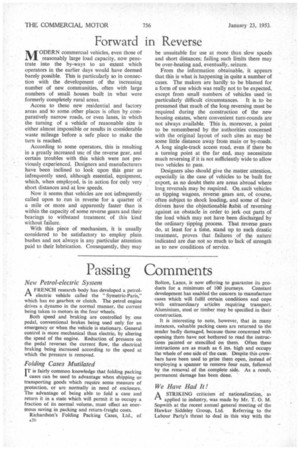Forward in Reverse
Page 22

If you've noticed an error in this article please click here to report it so we can fix it.
MODERN commercial vehicles, even those of reasonably large load capacity, now penetrate into the by-ways to an extent which operators in the earlier days would have deemed barely possible. This is particularly so in connection with the development of the increasing number of new communities, often with large numbers of small houses built in what were formerly completely rural areas.
Access to these new residential and factory areas and to some other places is often by comparatively narrow roads, or even lanes, in which the turning of a vehicle of reasonable size is either almost impossible or results in considerable waste mileage before a safe place to make the turn is reached.
According to some operators, this is resulting in a greatly increased use of the reverse gear, and certain troubles with this which were not previously experienced. Designers and manufacturers have been inclined to look upon this gear as infrequently used, although essential, equipment, which, when employed, is in action for only very short distances and at low speeds.
Now it seems that vehicles are not infrequently called upon to run in reverse for a quarter of a mile or more and apparently faster than is within the capacity of some reverse gears and their bearings to withstand treatment of this kind without failure.
With this piece of mechanism, it is usually considered to be satisfactory to employ plain bushes and not always is any particular attention paid to their lubrication. Consequently, they may be unsuitable for use at more than slow spceds and short distances; failing such limits there may be over-heating and, eventually, seizure.
From the information obtainable, it appears that this is what is happening in quite a number of cases. The makers are hardly to be blamed for a form of use which was really not to be expected, except from small numbers of vehicles used in particularly difficult circumstances. It is to be presumed that much of the long reversing must be required during the construction of the new housing estates, where convenient turn-rounds are not always available. This is, moreover, a point to be remembered by the authorities concerned with the original layout of such sites as may be some little distance away from main or by-roads. A long single-track access road, even if there be a turning point at the far end, may necessitate much reversing if it is not sufficiently wide to allow two vehicles to pass.
Designers also should give the matter attention, especially in the case of vehicles to be built for export, as no doubt there are areas abroad where long reversals may be required. On such vehicles as tipping wagons, reverse gears are, of course, often subject to shock loading, and some of their drivers have the objectionable habit of reversing against an obstacle in order to jerk out parts of the load which may not have been discharged by the ordinary tipping process. That reverse gears do, at least for a time, stand up to such drastic treatment, proves that failures of the nature indicated are due not so much to lack of strength as to new conditions of service.
























































































































































